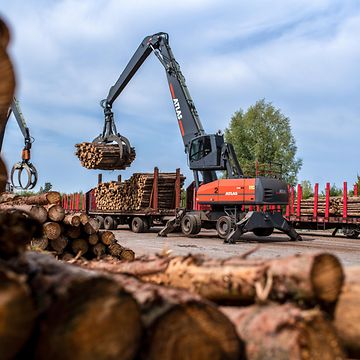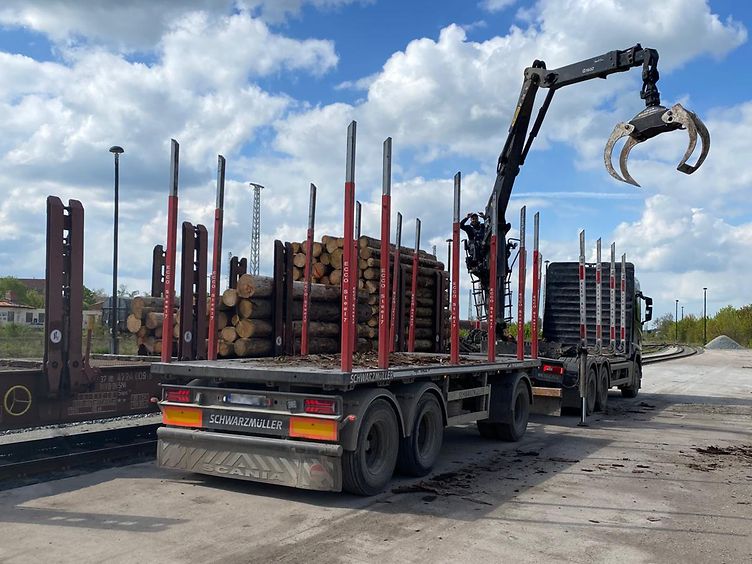Timber transport with the added benefit of logistics
From logs, square-sawn timber and chipboard to pellets – we offer customised solutions for the sustainable transport of all timber products.
Your advantages at a glance
- Rail-based timber transport for logs, square-sawn timber, pellets, chipboard and timber construction elements
- Access to the Europe-wide rail network for both single wagonload transport and individual block train solutions
- Customised timber logistics – also multimodal and intermodal for customers without own sidings
- Extensive special equipment, such as flexibly deployable freight wagons
- Use of CT-capable standard trailers for intermodal transport
- More than 80 percent CO2 savings compared to mere lorry transport

DB Cargo Logistics timber transport
- approx. 1600 freight wagons as part of the timber fleet
- over 200 timber loading yards throughout Germany
- 6 timberports for decoupling road and rail
- 2300000 tonnes of timber transported per year
Your expert partner
Our timber transport services are based on many years of experience with the timber industry both in Germany and throughout Europe. Experts in timber logistics develop customer-specific rail logistics concepts for the various timber products in close dialogue with you. We offer the most suitable and environmentally friendly transport route by rail for the natural raw material wood.
Efficient concentricity concepts for the timber industry
Rail freight transport works most efficiently when the wagons are loaded as continuously as possible. This is best achieved with sophisticated round trip concepts. We will show you how this can be achieved with a brief example:
Straight from the forest onto rails

Lorries take the logs directly from the forest to the nearest timber loading yard or timberport, where they are transferred onto the freight train. You can learn more about the role timberports in this process below.
Transport to the sawmill

The logs are transported by freight train to the sawmill, where they are further processed. Ideally, the sawmill has its own siding, otherwise the last mile is covered by lorry.
Handling and reloading in the sawmill

At the sawmill – or at a nearby rail access point – the wagons are unloaded and reloaded with square-sawn timber. This is one of the advantages of the flexible equipment, as the stanchion wagons can transport both logs and square-sawn timber.
Transport to the harbour

Loaded with square-sawn timber, the wagons then head from the sawmill to a seaport, for example.
Handling at the harbour

At the seaport, the packages of square-sawn timber are transshipped onto a ship for export. Square-sawn timber is exported in large quantities to North America, for example.
Back to the next timber loading yard

The only empty run in the round trip concept now takes place when the train travels to a timber loading yard to be reloaded and then restarts the round trip with fresh logs.
"With our equipment specially tailored to the timber industry and various services at the loading yards and timberports, we offer our customers sustainable logistics."

Timberports - how the decoupling of rail and road works
Among the more than 200 timber loading yards spread throughout Germany, there is a special type of rail access point for timber products, known as timberports. But what distinguishes them from conventional loading yards?
A "normal" timber loading point is exactly what it sounds like: a way of transferring logs from the forest from lorry to rail. Here there are clear time windows in which the freight wagons are standing by. The timber deliveries have to be precisely timed accordingly.

This already shows a decisive advantage of the timberport: extensive storage areas for logs enable timber shippers to deliver the timber from the forest at flexible intervals. The timber industry can then retrieve the required quantities at the timberport as needed. This results in more efficient lorry round trips, as there is no direct time connection between delivery and loading – thus decoupling road and rail from each other.

As timberports, unlike mere loading points, are not used exclusively for loading, they can be integrated into efficient round trips by rail. Freight trains, for example, can deliver square-sawn timber and continue on to the sawmill loaded with logs – timberports thus also ensure more effective equipment utilisation.

Get in touch with our expert.

Clemens Pflästerer
Head of Sales Timber, DB Cargo FLS





